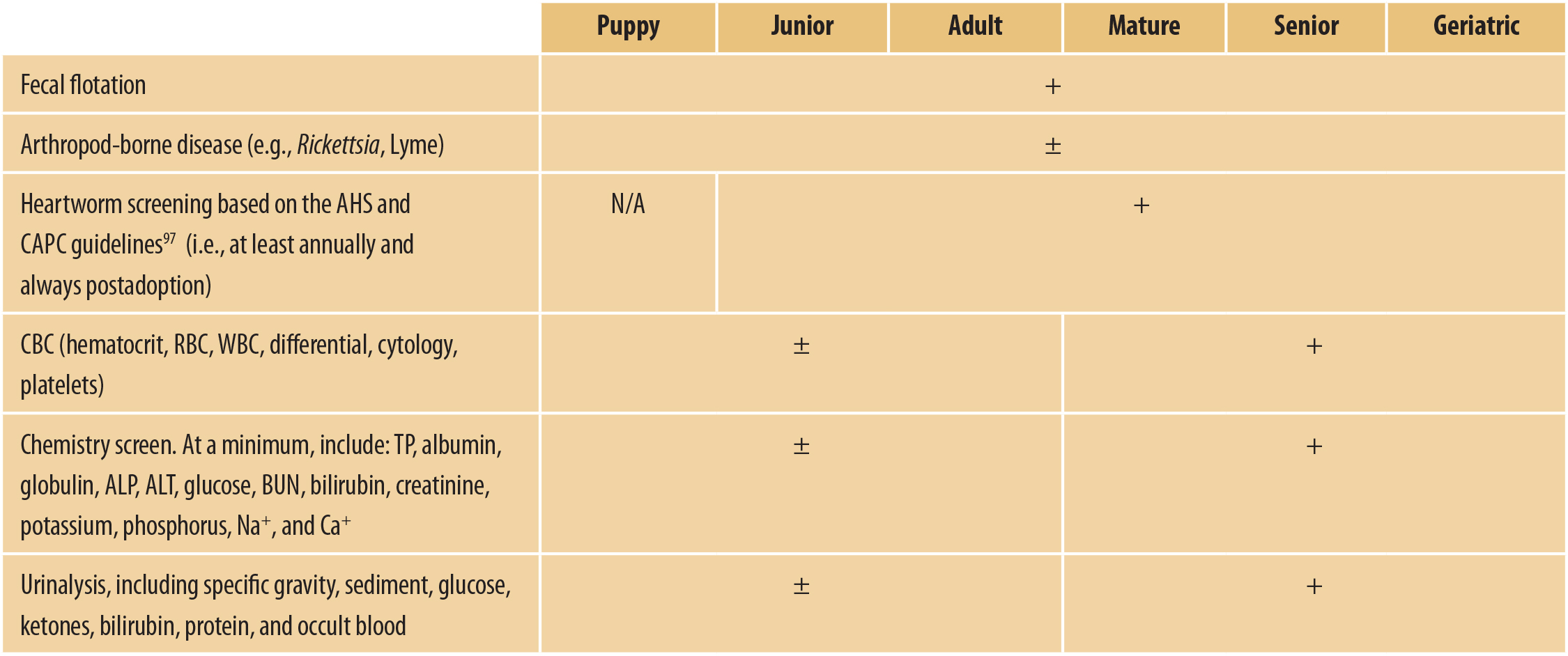Minimum databases for life stages
Routine tests such as the minimum database (Table 3) may be helpful for the wellness evaluation of any age dog, but are particularly important for the mature, senior, and geriatric patient, allowing early dedtection of disease or trends in clinical or laboratory parameters that may be of concern.4 Performed early in life, these tests may also provide a baseline for interpretation of data obtained at subsequent visits and may establish trends that would be more specific to the individual patient than cumulative laboratory data from many individuals.
Table 3 shows a “±” sign for many tests because there is limited evidence about exactly when to begin testing for each item.5,24–27Create individualized recommendations based on current evidence, clinical experience, and the dog’s specific breed and circumstances. Individualize the approach for each dog to ensure an effective plan for early disease detection and to maintain optimum health.
There are several hundred distinct canine breeds and many more mixed-breed dogs, each with different genetics and diverse lifestyles.28,29 At least two-thirds of dog breeds have at least one recognized genetic disorder.30 Various resources describe breed-specific normal values and disease predispositions. Understanding these can help guide decisions for testing.31–37 Be aware of whether your diagnostic laboratory includes information about specific breed variations of “normal values.” DNA testing in mixed-breed dogs may offer information to the veterinarian to be watchful for specific breed behavior tendencies or health concerns (e.g., orthopedic, cardiac, ophthalmologic, or drug sensitivity).
There are too many examples to list them all here; however, one example of a breed-specific test would be performing a urine protein-to-creatinine ratio in breeds predisposed to glomerulopathy.38 As other examples, blood pressure measurement or thyroid disease screening may be part of a wellness exam if the breed (or other findings) warrants monitoring these parameters.39 Measurement of blood pressure is discussed in detail elsewhere.40 Thyroid disease screening is also described in many texts.41
Work closely with clients who are involved with breeding programs. Promote responsible breeding practices, and encourage collaboration among breed associations, dog breeders, and university-based canine research programs. Using the current references on breed-specific disorders can reduce perpetuation of disease and promote wellness through careful selection of individuals used for breeding programs. See the current position statements of the AVMA and AAHA regarding procedures such as ear cropping, tail docking, dewclaw removal, and ownership of wolf-dog hybrids.
TABLE 3
Minimum Database by Age Group for the Apparently Healthy Animal*

*See text: “Individualized approach.”
Working and service dogs not only provide companionship, but also important service roles. These dogs must maintain optimum health and specific physical abilities to be available to perform or provide their special use or assistance.42–44 Clients with these high-performing dogs may opt for more frequent evaluations or specific preventive care.45 For optimizing wellness in these valuable service animals, it is vital to share the latest knowledge available.



